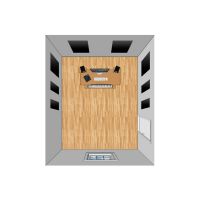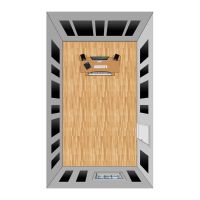Acoustic treatment is important for almost every situation. An untreated room will create numerous sonic problems including environmental noise, reverberations, reflections, standing waves and more. All of these sonic anomalies become distractions!
Whether it’s a studio, office, home-cinema or meeting room, acoustically treating your room will help you get the most out of your space and enhance your recording and listening experience dramatically.
"Our hearing is easily confused when listening to “echo-ee” or “muffled” recordings."
They will reduce and eliminate resonant frequencies and reverberation within your room or studio. The goal is to provide a more controlled audio environment which in turn offers a more natural and true sound you can trust.
Why do I need acoustic treatment?
An untreated room is a space that has no acoustic treatment applied to it, making it highly susceptible to reverberations and frequency build-up.
Acoustic treatment allows you to create the best recordings and make critical mix decisions with confidence. Boomy and boxy sounding rooms are often caused by frequencies bouncing around a space, accumulating in problem areas such as corners. This gives you a false representation of the room by enhancing or muffling certain frequencies, altering the sound you are hearing from your speakers, the sound your microphone is tracking, and ultimately your mix.
"In an untreated room, somewhere between 30% - 45% of what you or your mic will be recording is the room reflections."
No matter how good your gear is, your room could be the weak link in your setup and potentially ruin your recordings.
So, acoustically treating your room is just as important as picking the right microphone or audio interface and offers better audio integrity and sound definition, and in turn, sonically detailed recording, and productions.
The good news is acoustic treatment doesn’t have to be expensive or a time-consuming experience; it may simply be a case of installing a few acoustic panels in key areas to maximise your rooms potential.
This problem stretches beyond studios. Offices, conference rooms and cinemas all suffer from the same sonic issues and will greatly benefit from acoustic treatment. By treating your room you are absorbing sound issues at their reflection points before they can cause a problem.
Many rooms have a head start in the form of beds, curtains and sofas. All of these things help but will not provide the same results that dedicated acoustic treatment does.
Don't believe us?
We've made this useful video to show you the difference between the sound of an office space with and without any acoustic treatment.
How to control the bass in my room?
“Bass rumble” can be a significant problem, but this can be treated using bass traps. These are used in corners of studios and cinemas where low frequencies build up. Reduce and absorb them to prevent your room from experiencing standing waves.
"Low-frequency sound waves are inherently more powerful and unpredictable than high-frequency sound waves."
Bass traps are produced from thicker and more compact material to help them absorb lower frequencies (500hz or below). This form of acoustic treatment is different to the thinner acoustic panels that are designed for walls and ceilings, which tend to be between 25mm – 50mm in thickness and are effective from 500hz and above.
Soundproofing vs. Acoustic Treatment
In short, soundproofing is the process to control and minimise sound that passes from one space to another, for example, eliminating traffic noise.
Soundproofing is isolating your room from the outside noise, reducing sound leakage between multiple rooms, whilst keeping your sound in and removing noise pollution. This is required for live, rehearsal and recording studios, permanent vocal booths and cinemas.
"Mass equals sound reduction when it comes to soundproofing."
Soundproofing is typically a combination of porous materials such as Rockwool and plasterboard, installed within wall and ceiling cavities. It's not uncommon for them to be 50mm-100mm thick in order to absorb and disperse different frequencies before they leak out of your room.
Whereas acoustic treatment is employed to reduce the reverberation, reflections, and standing waves within a performance or control room. In other words, acoustic treatment creates the best possible sound environment to capture a clear and detailed performance.
Acoustic panels will not soundproof your room, but they will tame the liveliness of your space, making it more suitable for recording, mixing, performing, and even listening to music, whilst generally improving the acoustics of your room and changing the dynamics of how soundwaves move within a space.
Can I have too much Acoustic Treatment?
Yes is the simple answer. It is fundamental that when using acoustic treatment, that enough space is left between each panel to allow for the room to breathe. Too much acoustic panelling in a room can result in the room feeling dead and can create a proximity effect enhancing certain frequencies that would not normally resonate.
This will produce unnatural sounding recordings and create a space that is difficult to work with.
"These recordings will lack feeling, colour, depth and natural sound."
This will allow energy to reflect some controlled ambience back into space, the goal is to control ambience and reflections to taste. For a Voiceover artist, you will want quite a dry space of around 0.09ms of reflection or less. For drums, guitars or mixing a longer reflection time can be desirable.

 Price Match
Price Match Excellent support
Excellent support Trustpilot
Trustpilot FREE Delivery over £99*
FREE Delivery over £99* Spread payments with Klarna
Spread payments with Klarna






